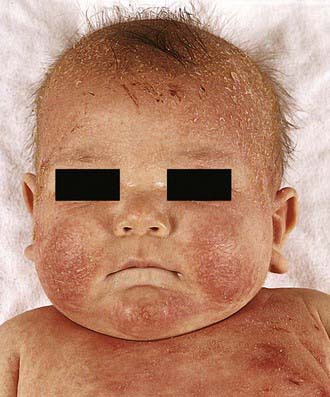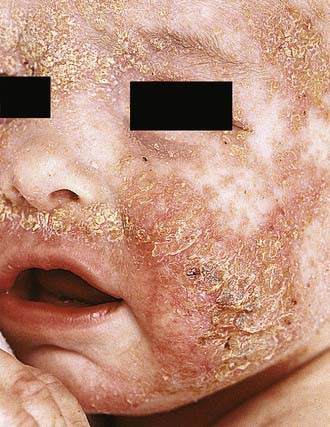Chapter 139 Atopic Dermatitis (Atopic Eczema)
Pathology
Acute AD skin lesions are characterized by spongiosis, or marked intercellular edema, of the epidermis. In AD, dendritic antigen-presenting cells (APCs) in the epidermis, such as Langerhans cells (LCs), exhibit surface-bound immunoglobulin (Ig) E molecules. These APCs play an important role in cutaneous allergen presentation to T helper type 2 (Th2) cells (Chapter 134). There is a marked perivenular T-cell infiltrate with occasional monocyte-macrophages in acute AD lesions. Mast cells are found in normal numbers but in different stages of degranulation. Chronic, lichenified AD is characterized by a hyperplastic epidermis with hyperkeratosis, and minimal spongiosis. There are predominantly IgE-bearing LCs in the epidermis, and macrophages in the dermal mononuclear cell infiltrate. Mast cell and eosinophil numbers are increased. Eosinophils contribute to allergic inflammation by secreting cytokines and mediators that augment inflammatory responses and induce tissue injury in AD through the production of reactive oxygen intermediates and release of toxic granule proteins.
Clinical Manifestations
Acute AD skin lesions are intensely pruritic with erythematous papules (Figs. 139-1 and 139-2). Subacute dermatitis manifests as erythematous, excoriated, scaling papules. In contrast, chronic AD is characterized by lichenification (Fig. 139-3), or thickening of the skin with accentuated surface markings, and fibrotic papules (prurigo nodularis). In chronic AD, all three types of skin reactions may coexist in the same individual. Most patients with AD have dry, lackluster skin irrespective of their stage of illness. Skin reaction pattern and distribution vary with the patient’s age and disease activity. AD is generally more acute in infancy and involves the face, scalp, and extensor surfaces of the extremities. The diaper area is usually spared. Older children and children with chronic AD have lichenification and localization of the rash to the flexural folds of the extremities. AD often goes into remission as the patient grows older, leaving an adolescent or adult with skin prone to itching and inflammation when exposed to exogenous irritants.

Figure 139-1 Atopic dermatitis, typical cheek involvement.
(From Eichenfield LF, Friedan IJ, Esterly NB: Textbook of neonatal dermatology, Philadelphia, 2001, WB Saunders, p 242.)
Diagnosis and Differential Diagnosis
AD is diagnosed on the basis of 3 major features: pruritus, an eczematous dermatitis that fits into a typical presentation, and a chronic or chronically relapsing course (Table 139-1). Associated features, such as a family history of asthma, hay fever, elevated IgE, and immediate skin test reactivity, are variably present.
Table 139-1 CLINICAL FEATURES OF ATOPIC DERMATITIS
MAJOR FEATURES
ASSOCIATED FEATURES
Many inflammatory skin diseases, immunodeficiencies, skin malignancies, genetic disorders, infectious diseases, and infestations share symptoms with AD and should be considered and excluded before a diagnosis of AD is established (Table 139-2). Severe combined immunodeficiency syndrome (Chapter 120.1) should be considered for infants presenting in the 1st year of life with diarrhea, failure to thrive, generalized scaling rash, and recurrent cutaneous and/or systemic infection. Histiocytosis (Chapter 501) should be excluded in any infant with AD and failure to thrive. Wiskott-Aldrich syndrome (Chapter 120.2), an X-linked recessive disorder associated with thrombocytopenia, immune defects, and recurrent severe bacterial infections, is characterized by a rash almost indistinguishable from that in AD. Hyper-IgE syndrome (Chapter 120.2) is characterized by markedly elevated serum IgE values, recurrent deep-seated bacterial infections, chronic dermatitis, and refractory dermatophytosis.
Table 139-2 DIFFERENTIAL DIAGNOSIS OF ATOPIC DERMATITIS
CONGENITAL DISORDERS
CHRONIC DERMATOSES
INFECTIONS AND INFESTATIONS
MALIGNANCIES
AUTOIMMUNE DISORDERS
IMMUNODEFICIENCIES








